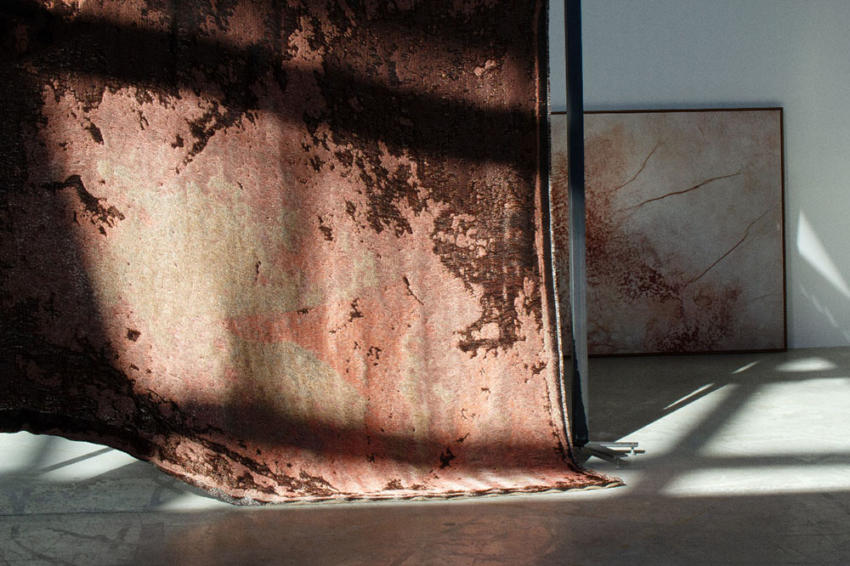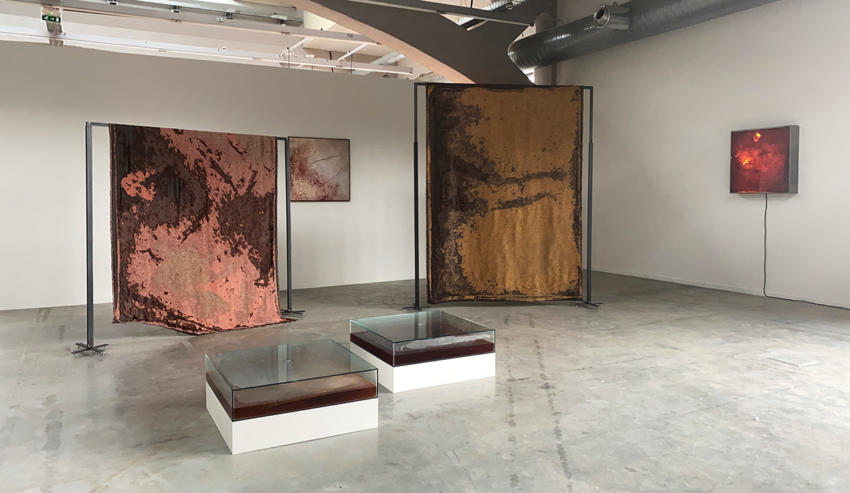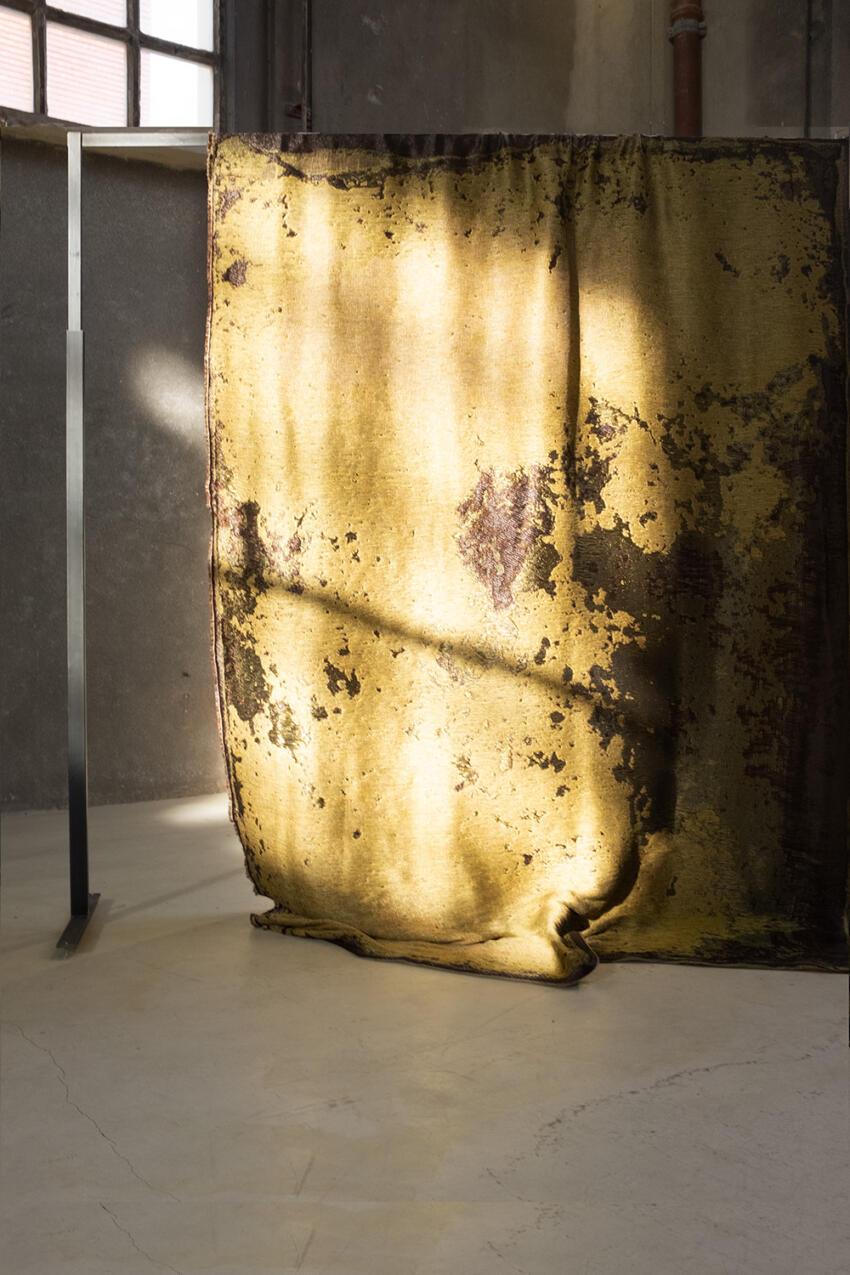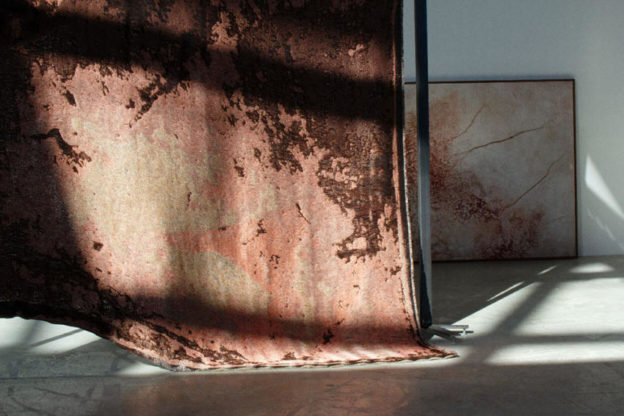A woven topographic view visualizes the ecology of a symbiotic organism. It translates the collaboration between Acetobacter xylinum bacteria and Saccharomyces cerevisiae yeast cells. The original Sensorial Skins were grown in a culture of fresh hibiscus tea for the pink, and campèche-colored tea for the orange. The tapestries offer a play of light shining through the lightly woven, multi-layered work, reminiscent of the multiple layers woven by bacteria in the original Sensorial Skin from which these tapestries are translations into another medium. The tapestries are woven in 7 layers on a computer-controlled, state-of-the-art Dornier Jacquard weaving machine at the TextielLab in Tilburg (Nl), with an array of organic fibers: linen, paper, polyester, elirex and cotton.

A woven topographic rendering visualizes the ecology of my rooftop garden. Interactions between plants, insects, bacteria and the abiotic elements as temperature, light, water and wind. Each tapestry is 225cm x 170cm.

Poems from a Rooftop Garden (installation at La Kunsthalle, Mulhouse – 2023) : the tapestries pink and orange, a red lightbox with a dried Sensorial Skin, a photograph of a Sensorial Skin and 2 aquariums in which new Sensorial Skins are growing during a fermentation process.
‘Poems from a Rooftop Garden’ : The installation at La Kunsthalle, Mulhouse (2023).
The biofilm produced by the combined cultures of bacteria and yeast is the material that ties the works in this collection together. From their visible growth in real time, to their leathery state after harvesting, to the reworking of their patterns on other substrates, Maes unveils the full range of possibilities offered by these organic constructions.
The skins are incubated in fermentation aquariums filled with a nutrient medium that allows microorganisms to develop. A symbiosis of elements then takes place, and a film develops over the surface of the liquid. This film is normally used by the microbial colony as a protective seal.
Once completed and harvested, the membrane is treated by the artist and becomes what she calls a sensorial skin. Maes uses the flexible skin, ever sensitive to the temperature and humidity of its environment, in many of her works. The leather substitute’s delicate transparency reveals its patterns to the naked eye thanks to the light of illuminated boxes.
Seen through the prism of photography, the details of this biofilm blur our perception. We have the feeling of seeing both microscopic forms and topographical maps. The folds and marks that can be observed are like the scars on human skin.
The two tapestries spread out in this space can be seen as a form of mimesis. They are arranged in such a way as to represent the specific patterns of the biofilm, while echoing the multiple layers woven together by bacteria. Despite its seven layers of partially organic fibers, the airy weave lets the light shine through just as the sensorial skin does. As in the case of macrophotography, this change of medium allows the size of the biofilm patterns to be multiplied, rendering visible that which is not easily seen by the naked eye.

A woven topographic rendering visualizes the ecology of my rooftop garden. Interactions between plants, insects, bacteria and the abiotic elements as temperature, light, water and wind. Installation shot at Fondation Fiminco, Symbiosium.
(Nl) Het fysieke weefwerk is een monochroom, of beter: 3 monochromen (oranje, roze en groen) die samen 1 monumentaal geheel vormen, maar die ook elk op zich kunnen staan. De werken zijn een gewoven visualisatie van een materiaal waar ik veel mee werk: microbial skin. Dit materiaal wordt gegroeid door een samenwerking van bacterieën en gistcellen tijdens een fermentatieproces. Ik noem deze materialen mijn ‘Sensorial Skins’, omdat ze enorm tactiel zijn, en zeer responsief aan atmosferische omstandigheden, net als echte huid. De originele Sensorial Skins werden gekweekt door de bacterie- en gistcellen in een cultuur van verse hibiscusthee voor het roze, en campèche-kleurige thee voor het oranje. De weefwerken bieden een spel van licht dat door het open-geweven, meerlagige werk schijnt, dat doet denken aan de meerdere lagen die door bacteriën in een originele Sensorial Skin worden geweven. De werken zijn geweven met 7 organische garens (zoals linnen, papier, polyester, elirex en katoen) op een ultramoderne computergestuurde Dornier Jacquard weefmachine in het TextielLab in Tilburg (Nl).
